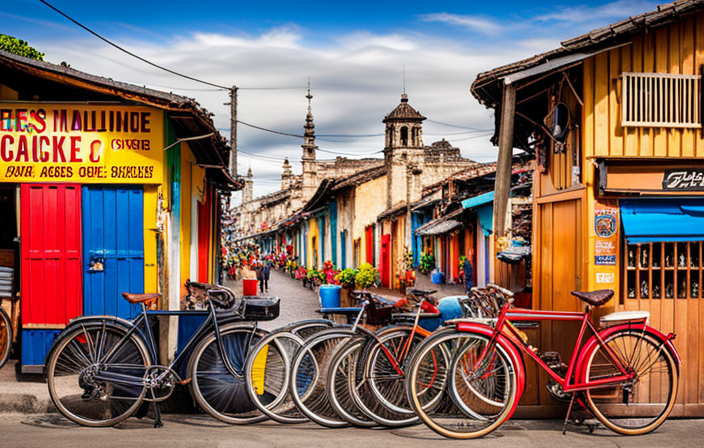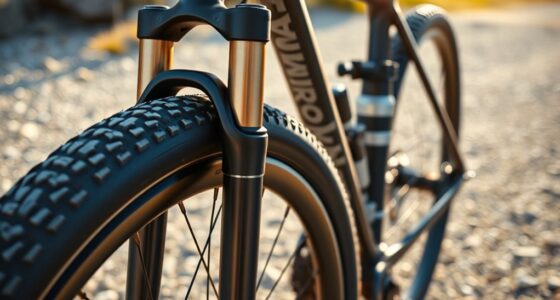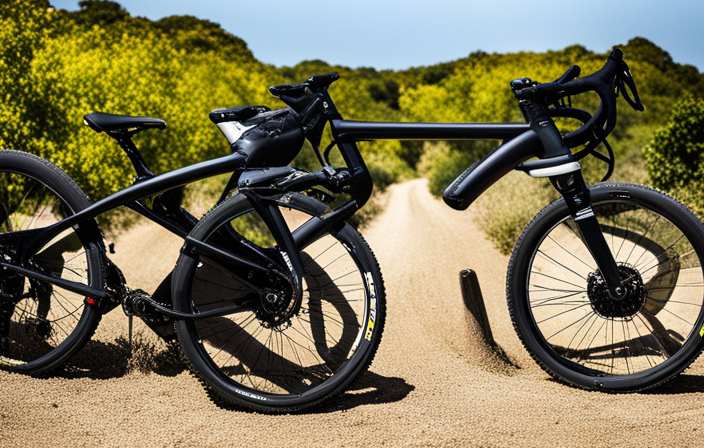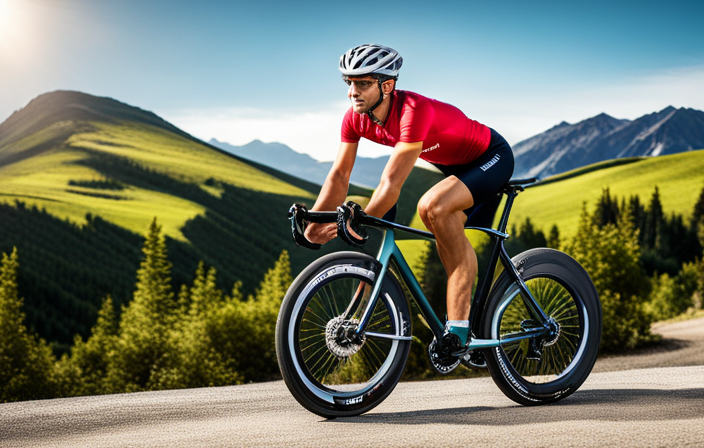Picture this: You’re a passionate cyclist, eager for a fresh experience. You have a strong desire to venture off the usual routes, surrounded by nature’s wonders and conquering rugged terrain. A gravel bike route is the perfect solution – offering an exciting blend of difficulty and serenity just waiting to be discovered.
In this article, I’ll guide you through the process of creating your own gravel bike route. From planning to packing essentials, we’ll cover everything you need to know for an unforgettable ride.
Let’s get started!
Key Takeaways
- Determine Distance and Duration Preferences
- Research Local Trails and Scenic Areas
- Consider Terrain and Difficulty Level
- Plan for Rest Stops and Refueling Points
Determine Your Distance and Duration Preferences
Decide how far and how long you want to ride on your gravel bike route. Before embarking on your adventure, it’s essential to determine your distance and duration preferences. This will help you plan accordingly and ensure a enjoyable experience.
Firstly, consider the distance you are comfortable riding. Do you prefer shorter rides of around 10-20 miles or longer rides exceeding 50 miles? Evaluating your endurance level will guide you in choosing an appropriate route length that suits your fitness level.
Next, think about the duration of your ride. Are you looking for a quick two-hour jaunt or do you have the entire day to explore? Keep in mind that gravel biking can be more challenging than road cycling due to rougher terrain and varying conditions, so adjust your time expectations accordingly.
Additionally, determining your elevation gain is crucial when planning a gravel bike route. Gravel roads often include climbs and descents, adding excitement to your ride. Consider whether you enjoy tackling steep hills or prefer flatter sections for a more leisurely journey.
To find local gravel routes that match your preferences, research local trails and scenic areas renowned for their gravel paths. Seek recommendations from fellow cyclists or consult online platforms dedicated to mapping out such routes.
By deciding on the distance, duration, and elevation gain that align with your goals, as well as researching local trails and scenic areas suitable for gravel biking adventures, you’ll be ready to embark on an exciting journey through picturesque landscapes without compromising comfort or enjoyment.
Research Local Trails and Scenic Areas
Explore the surrounding area to find nearby trails and picturesque spots. Start by researching local trails and scenic areas that are suitable for gravel biking. Look for trails that are well-maintained, ensuring a smoother and more enjoyable ride. It’s also helpful to check if there are any local cycling events or groups that can provide information on popular routes in the area.
When researching, consider the following:
-
Trail maintenance: Look for trails that are regularly maintained to ensure a safe and pleasant riding experience. Check if there are any trail organizations or volunteers who actively work on maintaining the paths.
-
Local cycling events: Pay attention to any upcoming cycling events in your area as they often showcase some of the best routes available. Participating in these events can be a great way to discover new trails and meet fellow gravel bikers.
-
Scenic areas: Seek out trails that pass through scenic spots such as parks, lakes, or mountains. These areas not only provide breathtaking views but also add an extra element of enjoyment to your ride.
By exploring local trails and scenic areas, you will gather valuable information about potential routes for your gravel bike adventure. Once you have an idea of the available options, it’s time to consider the terrain and difficulty level without compromising safety or fun.
Consider the Terrain and Difficulty Level
Take into account the type of terrain and the level of difficulty you are comfortable with when planning your gravel biking adventure. Terrain analysis is an important step in determining whether a route is suitable for your skill level and bike capabilities. Consider factors such as elevation changes, surface conditions, and technical features like loose gravel or rocky sections. To help you evaluate the terrain, use a difficulty rating system that categorizes routes based on their level of challenge. This can be especially useful if you are new to gravel biking or unfamiliar with the area you plan to ride in.
To assist you further, here’s a table that illustrates different types of terrain and their corresponding difficulty levels:
| Terrain Type | Difficulty Level |
|---|---|
| Flat roads | Easy |
| Rolling hills | Moderate |
| Steep climbs | Challenging |
| Technical trails | Advanced |
| Rocky surfaces | Expert |
By considering both the type of terrain and its difficulty level, you can choose a route that aligns with your abilities and preferences. Once you have assessed these factors, it’s time to plan for rest stops and refueling points along your journey.
Plan for Rest Stops and Refueling Points
Consider planning for rest stops and refueling points along your journey to ensure that you have enough energy and sustenance throughout your gravel biking adventure. It’s important to strategically choose rest stop locations and take advantage of refueling options along the way.
Here are some tips to help you plan for these essential pit stops:
- Research nearby towns or establishments where you can find restrooms, water fountains, or picnic areas.
- Look for convenience stores or gas stations along your route that offer snacks, drinks, and other quick fuel options.
- Consider carrying lightweight snacks such as energy bars, nuts, or dried fruits in case there are limited refueling options available.
- Take note of any local cafes or restaurants that might serve as good lunch spots where you can replenish your energy with a hearty meal.
- If possible, try to plan your route near parks or scenic spots where you can take a break from pedaling and enjoy the surroundings.
By planning ahead and considering these rest stop locations and refueling options, you’ll be better prepared for your gravel biking adventure. After all, ensuring that you have enough fuel is crucial for an enjoyable ride. Once you’ve planned out these essential elements of your route, it’s time to use mapping tools and apps to plot your course through the gravel roads.
Use Mapping Tools and Apps to Plot Your Route
Using mapping tools and apps can be helpful in plotting your desired route for your gravel biking adventure. These tools provide a range of features that make route planning easier and more efficient. One key feature is the ability to customize your route based on specific preferences, such as distance, terrain, and points of interest. With just a few clicks, you can select the roads or trails that are best suited for gravel biking.
Mapping tools also offer elevation tracking, which is crucial for gravel biking routes. You can see the elevation profile of your chosen route, allowing you to prepare mentally and physically for any challenging climbs or descents along the way.
Furthermore, these tools often provide turn-by-turn directions and real-time navigation, ensuring that you stay on track throughout your ride. Some apps even offer offline maps, so you don’t have to worry about losing connection in remote areas.
In conclusion, utilizing mapping tools and apps for route planning is an essential step in creating a successful gravel bike route. By taking advantage of their customizable features and elevation tracking capabilities, you can design a route that suits your preferences and abilities.
As you plot your course using these handy tools, it’s important to also take note of road conditions and traffic to ensure a safe and enjoyable ride ahead without compromising on road safety awareness.
Take Note of Road Conditions and Traffic
It’s important to be aware of the road conditions and traffic while planning your gravel biking adventure. Riding on gravel roads can present different challenges compared to riding on paved roads, so it’s crucial to know what you’re getting into.
Before hitting the trail, check for any recent weather events that may have affected the road conditions. Heavy rain or snow can make gravel roads muddy and slippery, making it more difficult to navigate. It’s also essential to consider the grade and elevation changes along your route, as steep inclines or descents can impact how easily you can ride through certain sections.
Additionally, take note of any potential hazards such as potholes or loose gravel that could pose a risk during your ride. Keep an eye out for signs indicating road work or construction zones that may require detours or temporary closures. Furthermore, familiarize yourself with local traffic regulations and share the road responsibly with other vehicles if necessary.
By being mindful of road conditions and practicing proper traffic management techniques, you’ll ensure a safer and more enjoyable gravel biking experience.
With this knowledge in mind, we can now move on to incorporating points of interest or landmarks into our route planning without missing a beat.
Incorporate Points of Interest or Landmarks
To enhance your gravel biking adventure, don’t forget to include points of interest or landmarks along your route. These can add excitement and variety to your ride, making it more enjoyable and memorable. Points of interest can be anything from natural wonders like waterfalls or scenic overlooks, to historical sites such as old buildings or monuments. Landmark attractions could include famous landmarks like the Eiffel Tower, the Great Wall of China, or the Grand Canyon.
Incorporating these points of interest into your gravel bike route will not only provide you with interesting sights to see but also give you opportunities for rest stops, photo ops, and a chance to learn more about the area you’re riding through. To help you plan your route effectively and incorporate these points of interest seamlessly, consider creating a table that lists each landmark attraction along with its location, distance from the starting point, and any additional information or special notes about it.
By including these points of interest in your gravel bike route, you’ll have a more enriching experience while exploring new places on two wheels. After planning out all the exciting stops along your journey, it’s important to check for any permits or restrictions that may apply before setting off on your adventure.
| [//]: # (Table) | Landmark Attraction | Location | Distance from Starting Point |
|---|---|---|---|
| Waterfall | Forest Park | 5 miles | |
| Historical Building | Downtown | 10 miles | |
| Scenic Overlook | Mountain Top | 15 miles |
Now that we’ve covered incorporating points of interest into your gravel bike route let’s move on to checking for any permits or restrictions before embarking on this thrilling adventure.
Check for Any Permits or Restrictions
Before embarking on this exciting adventure, be sure to check for any permits or restrictions that may apply. It’s essential to familiarize yourself with the permit requirements and local regulations of the area where you plan to create your gravel bike route. This will ensure that you are compliant with any necessary permissions needed for your ride.
To assist you in this process, here are some key points to consider:
-
Research permit requirements: Contact the local authorities or park management to determine if a permit is necessary for creating a gravel bike route in the specific area you have chosen.
-
Understand local regulations: Familiarize yourself with any rules or guidelines governing outdoor activities such as biking in the region. Be aware of any restricted areas or sensitive ecosystems that should be avoided.
-
Check seasonal restrictions: Some areas may have seasonal restrictions due to weather conditions or environmental concerns. Make sure you are aware of any limitations during certain times of the year.
-
Obtain necessary permits: If permits are required, ensure that you obtain them before starting your gravel bike route.
After confirming all permit and restriction requirements, it’s time to consider safety measures and emergency preparedness for your adventure.
(Note: Transition into subsequent section about ‘consider safety measures and emergency preparedness.’)
Consider Safety Measures and Emergency Preparedness
Ensure your safety and be prepared for emergencies by taking necessary precautions on your adventure. When planning a gravel bike route, it is essential to consider safety measures and emergency preparedness.
One crucial aspect is having an emergency response plan in place. Research the area you will be riding through and determine the availability of emergency services or nearby hospitals. Additionally, ensure that you have a reliable means of communication, such as a fully charged cell phone or a two-way radio.
Another vital safety consideration is acquiring first aid training. Accidents can happen anywhere, so being equipped with basic first aid knowledge can make a significant difference in handling injuries until professional help arrives. Learn how to administer CPR, treat minor wounds, and recognize signs of more severe conditions like heatstroke or hypothermia.
In terms of equipment, always carry a well-stocked first aid kit that includes bandages, antiseptic wipes, pain relievers, and any necessary medications specific to your needs. It’s also wise to bring along extra water and food supplies in case of unexpected delays or emergencies.
By prioritizing safety measures and being prepared for potential emergencies with appropriate training and equipment, you can confidently embark on your gravel bike adventure knowing that you are well-prepared for any situation that may arise.
Now let’s move on to the next section about testing your route and making adjustments as needed…
Test Ride and Adjust Your Route as Needed
After considering safety measures and emergency preparedness, it’s time to test ride your gravel bike route. This step is crucial as it allows you to determine if the route is suitable for your biking abilities and preferences. By getting on your bike and actually riding the route, you can experience firsthand any potential challenges or areas that may need adjustments.
During the test ride, pay attention to factors such as road surface conditions, traffic volume, and any potential hazards along the way. Take note of any sections that feel uncomfortable or unsafe and consider alternative routes or adjustments that could improve the overall experience.
To help you keep track of these observations, I’ve created a table below:
| Observation | Issue | Solution |
|---|---|---|
| Bumpy road | Uncomfortable ride | Consider a different route with smoother surfaces |
| High traffic area | Unsafe crossing | Find an alternate path or time to avoid heavy traffic |
| Lack of signage | Difficult navigation | Add clear markers or directions for better guidance |
By systematically evaluating these aspects during your test ride, you can make necessary adjustments to ensure a safer and more enjoyable gravel biking experience.
Now that we have fine-tuned our route through testing, it’s time to share it with friends or cycling communities for their input and feedback.
Share Your Route with Friends or Cycling Communities
Once you’ve tested and adjusted your route, it’s a great idea to share it with friends or cycling communities for their input and feedback. Sharing your route can help you gather valuable insights from experienced riders who may have suggestions for improvements or alternate paths.
You can reach out to friends who are familiar with gravel biking or join online cycling communities where you can post your route details and ask for advice.
When sharing your route with friends, make sure to include all relevant information such as distance, elevation gain, road conditions, and any potential hazards. This will help them provide more accurate feedback and recommendations.
Additionally, consider joining local cycling groups or online platforms dedicated to gravel biking enthusiasts. These communities often have members who are knowledgeable about the best routes in the area and can offer valuable insights on how to make your gravel bike route even better.
By sharing your route with friends and engaging with cycling communities, you’ll be able to tap into a wealth of collective knowledge that can enhance your riding experience. Now that you have gathered feedback on your proposed route, let’s move on to packing essential gear and supplies for a safe and enjoyable ride.
Pack Essential Gear and Supplies
To have a safe and enjoyable ride, it’s important to pack all the essential gear and supplies. Here are three items that you should bring with you on your gravel bike route:
-
Helmet: The most crucial piece of gear for any cyclist is a helmet. It provides protection for your head in case of accidents or falls. Make sure to choose a helmet that fits properly and meets safety standards.
-
Repair kit: Flat tires can happen at any time, so it’s essential to carry a repair kit with you. This should include spare inner tubes, tire levers, a pump or CO2 inflator, and a multi-tool for basic repairs.
-
First aid kit: Accidents can occur on the trail, so having a first aid kit is vital for emergency preparedness. Your kit should include bandages, antiseptic wipes, pain relievers, and any necessary personal medications.
By packing these essential gear and supplies, you’ll be ready to handle any situations that may arise during your gravel bike ride.
In the next section about staying hydrated and fueling up during the ride, it’s important to prioritize your health and well-being while cycling long distances without compromising speed or endurance.
Stay Hydrated and Fuel Up During the Ride
During your ride, it’s important to stay hydrated and fuel up to maintain your energy levels. Hydration is crucial when cycling, especially on longer gravel rides. Make sure to drink plenty of water before you start and carry a water bottle or hydration pack with you. It’s also helpful to have electrolyte drinks or hydration tablets to replenish the minerals lost through sweat. Sip on fluids regularly throughout the ride, even if you don’t feel thirsty.
As for fueling strategies, it’s essential to consume carbohydrates for sustained energy. Pack snacks like energy bars, gels, or fruits that are easy to eat on the go. Aim for small portions every hour or so to keep your energy levels steady. Additionally, consider incorporating some protein-rich snacks like nuts or jerky to support muscle recovery during longer rides. Remember that everyone’s nutritional needs vary, so experiment with different foods and find what works best for you.
By staying hydrated and fueled up properly, you’ll be able to enjoy your gravel bike route without feeling fatigued.
Now that we’ve covered how to stay hydrated and fuel up during the ride, let’s talk about another important aspect: taking breaks and enjoying the scenery along the way.
Take Breaks and Enjoy the Scenery
Taking breaks and savoring the beautiful scenery is a key part of enjoying your gravel ride. Not only does it give your body a chance to rest, but it also allows you to appreciate the surroundings and take in all the beauty that nature has to offer. One of my favorite things to do during these breaks is to take photos. Gravel bike routes often take you through stunning landscapes, and capturing these moments on camera allows you to relive the experience later.
In addition to taking photos, I also enjoy exploring the wildlife that I come across during my rides. Whether it’s spotting birds in the trees or catching a glimpse of a deer running through a field, there’s something magical about encountering animals in their natural habitat. It reminds me how connected we are to nature and how important it is to preserve these spaces for future generations.
| [table] | Column 1 | Column 2 | Column 3 |
|---|---|---|---|
| Rest | Appreciate | Reflect | |
| Recharge | Capture | Preserve | |
| Relax | Explore | Connect |
By taking breaks and enjoying the scenery, you not only enhance your riding experience but also create memories that will last a lifetime. So, as you continue your gravel bike adventure, don’t forget to pause, snap some photos, and immerse yourself in the beauty around you. Reflecting on your experience and sharing your adventure with others will surely inspire them to embark on their own thrilling gravel rides.
Reflect on Your Experience and Share Your Adventure
Reflecting on my experience and sharing my adventure with others is a great way to inspire them to embark on their own thrilling gravel rides. There’s something special about exploring new routes and discovering the hidden gems that can only be found off-road.
One of my favorite gravel bike routes is the Blue Ridge Parkway in North Carolina. The stunning mountain views, challenging climbs, and smooth gravel make it an unforgettable ride.
When planning a gravel bike adventure, there are a few tips I’ve learned along the way. First, research local cycling groups or online communities that share their favorite routes. These riders often have inside knowledge of lesser-known paths that offer unique experiences. Second, consider the terrain and difficulty level when choosing a route. Gravel roads can vary greatly in condition, so it’s essential to have the right tires and gear for your ride.
Another important aspect of sharing your adventure is documenting it through photos or videos. Not only does this allow you to relive the memories later on, but it also gives others a visual glimpse into what they can expect from their own gravel bike journey.
Finally, don’t be afraid to share tips and advice with fellow riders who are interested in trying out gravel biking for themselves. By encouraging others to explore this exciting niche within cycling, we can create a community of adventurers who push each other to discover new horizons on two wheels.
Frequently Asked Questions
Can I use a road bike for a gravel bike route?
Yes, a road bike can be used for a gravel bike route, but there are some limitations to consider.
The narrow tires and lightweight frame of a road bike may make it less suitable for rough terrains and loose gravel. However, with proper caution and adjustments like wider tires and lower tire pressure, you can still enjoy the experience.
Alternatively, considering other bike options specifically designed for off-road adventures may provide a more optimal experience on gravel routes.
Are there any specific types of tires that are recommended for gravel biking?
When it comes to gravel biking, the right tires can make all the difference.
There are a variety of gravel bike tire options available, each with their own strengths and weaknesses.
From wider tires for added stability to knobby tread patterns for better grip on loose terrain, choosing the best tires for your gravel adventures is crucial.
Additionally, finding the optimal tire pressure is key to achieving a smooth and comfortable ride while maintaining control on rough surfaces.
How do I navigate and follow the route while riding?
To navigate and follow a route while riding, I use various techniques and GPS devices.
First, I plan my route using mapping software or websites that offer gravel bike routes. Then, I transfer the route to my GPS device or smartphone app.
While riding, I rely on turn-by-turn directions provided by the GPS device or app to stay on track. Additionally, I pay attention to road signs and landmarks to ensure I’m following the correct path.
What are some common safety tips for riding on gravel roads?
Looking to stay safe while riding on gravel roads? Here are some essential tips for gravel bike riding.
-
First, make sure your bike is properly maintained with the right tire pressure and tread.
-
Next, always wear a helmet and consider using knee and elbow pads for added protection.
-
Keep a steady pace to maintain control and avoid sudden braking or turning.
-
Lastly, be cautious of loose gravel patches and adjust your technique accordingly.
Happy riding!
How can I find and connect with local cycling communities in the area?
To find local cycling groups and connect with fellow riders in the area, I recommend starting by searching online platforms like Meetup or Facebook. These platforms often have dedicated groups for cyclists where you can join discussions, find out about group rides, and even organize your own gravel ride.
Additionally, reaching out to local bike shops or cycling clubs is a great way to get involved and meet like-minded individuals who share your passion for riding on gravel roads.
Conclusion
As I reached the top of the final climb on my gravel bike route, I couldn’t help but feel a sense of accomplishment. The challenging terrain and breathtaking scenery had made every pedal stroke worth it.
Just like in life, our routes may be filled with ups and downs, but it’s how we navigate them that truly matters. So next time you’re planning a gravel adventure, remember to embrace the journey, take breaks when needed, and enjoy the beautiful landscapes along the way.
Happy riding!









